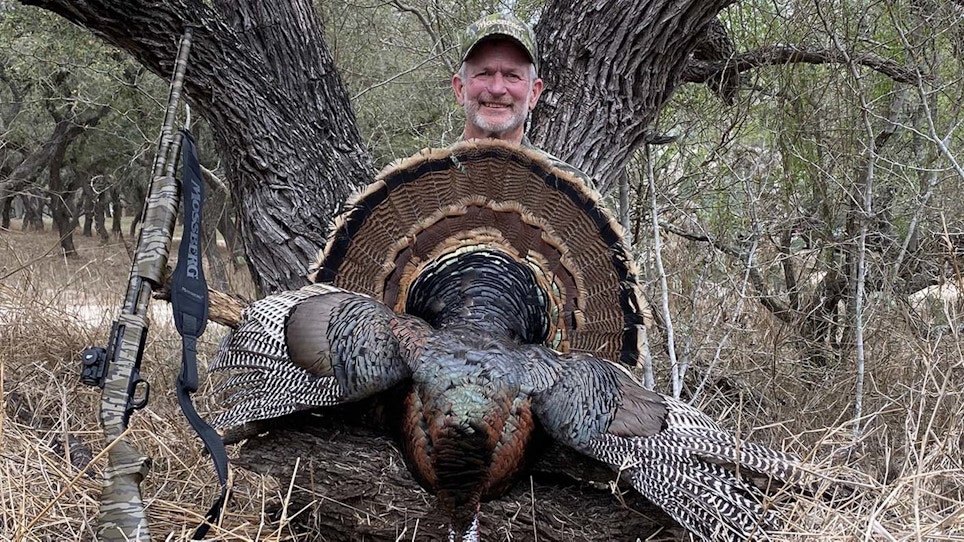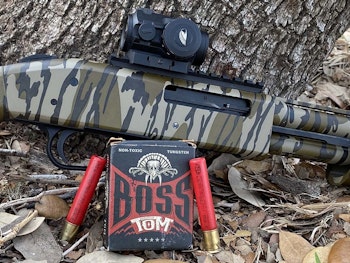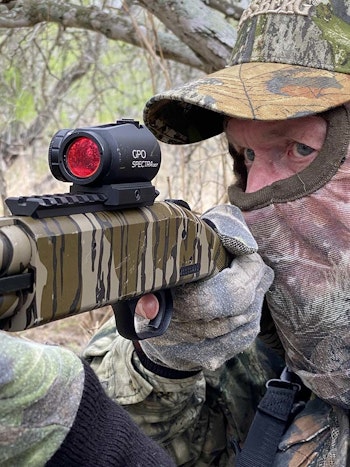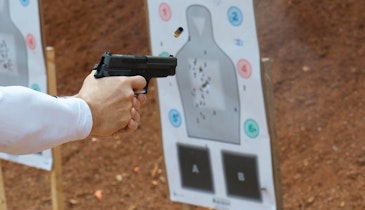The wild turkey is a tough critter. As in all hunting, the goal is to make a quick, clean kill, and when hunting a hard-headed gobbler with a shotgun, that means getting maximum pellets into the head/neck area delivered with enough kinetic energy to penetrate the skull and/or break the neck.
I first started turkey hunting in the early 1970s, when hunting loads contained only chilled or slightly-hardened lead shot and there was no such thing as a screw-in choke tube. Turkey-specific shotshells were an anomaly, and most gobbler getters turned to either 2 3/4- or 3-inch 12-gauge waterfowl loads filled with No. 4, No. 5, or maybe No. 6 shot sent downrange through a full choke. No turkey guns back then had an optic sight, and only a few slug guns had more than a front bead sight. The thought of using a 20-gauge shotgun was considered foolishness, and few even considered a smaller gauge shotgun. A 40-yard shot was stretching it back then.
Today, of course, the specialized turkey gun has become an industry unto itself. Designs that allow the gun to be aimed more like a rifle than a shotgun, fiber-optic open sights, the ability to add an optic sight, and interchangeable choke tubes designed specifically for today’s incredible turkey shotshells have made yesterday’s “way out there” 40-yard shot pretty much a slam dunk for the skilled hunter who has taken the time to pattern his gun and know its — and his own — limitations. This, in turn, has made using shotgun gauges smaller than the 12 viable — and increasingly popular.
Properly set up and fed the right ammunition, the 3-inch 20-gauge turkey gun is extremely lethal, and lighter to pack around the woods, and it produces measurably less recoil than the old-school 3-inch 12-gauge. Taking that to the next level today is the use of the .410 bore as an effective turkey hunting tool.
Why a .410 for Turkeys?
At first blush, turkey hunting with a .410 may seem like crazy talk. If you want to drop down below the 12 gauge, why not use a 20?
The .410 makes sense when you think about youth and small-framed hunters, as well as first-timers who might be a little recoil shy. It’s light and easy to carry (and .410 shotshells are way smaller and lighter than 12-gauge shotshells, too,) which also makes a .410 an excellent choice for run-and-gun hunting. For example, the popular 3-inch Mossberg 500 .410 Turkey Gun and Mossberg SA-410 Turkey autoloader, both with Mossy Oak Bottomland camo finish, weigh just 6½ pounds with 24- and 26-inch barrels, respectively. Both come with an extended choke tube (X-Full in the 500, XX-Full in the autoloader) and fiber-optic sights. The 500 is drilled and tapped so you can add a Picatinny rail, while the autoloader has a Pic rail installed, and thus, an optical sight can be easily added.
As is the case with any turkey-hunting shotgun, choosing a .410 shotgun built specifically for the task at hand is several steps above using the old .410 you’ve had for years. At the same time, these turkey guns can also have a place in a dove field, hunting small game like rabbits and squirrels, or on a clay target range, too.
The Ammunition Is Everything (Almost)
While turkey-specific .410 shotguns are The Bomb, what really has made it all possible is the introduction of shotshells filled with heavier-than-lead shotgun pellets. Together with wads designed for the task at hand, this changed the game exponentially.
TSS (Tungsten Super Shot) is an incredibly dense shot — the material is 56 percent denser than lead and 22 percent denser than tungsten — which means that turkey hunters can now use smaller pellet sizes than is the case with lead shot while achieving greater terminal performance. Tests have shown that a No. 9 TSS pellet will penetrate as deeply as a No. 5 lead pellet at all practical distances. That means regardless of the gauge shotgun you’re hunting with, using this type of ammunition allows you to send a whole lot more pellets downrange without losing the load’s lethality.
This is what makes the .410 a viable turkey-hunting gun today. Most 3-inch TSS-filled .410 turkey loads feature 13/16-ounce of No. 9 shot encased in a specialized, full-length wad designed to prevent direct contact of the super-hard TSS with the barrel. Typically this load contains about 295 pellets. In comparison, a 2-ounce load of 12-gauge, 3-inch, No. 4 lead shot contains about 270 pellets. Testing done by engineers at Federal Premium using a shotgun with a 24.5-inch barrel and fixed full choke averaged 125 to 150 pellets in a 10-inch circle at 40 yards. These numbers are capable of cleanly killing a wild turkey at that distance and even rival the numbers produced by some 12-gauge turkey guns using No. 4 or No. 5 lead loads. In addition, test results also showed more than 3 inches of penetration in ballistic gel and deep dents, with a few pellets even busting completely through a thin sheet of steel at 40 yards.
As we like to say, they just can’t take a lot of that!
Optic Sights Make a Difference, Too
The diminutive .410 bore gun produces a narrow shot pattern with an elongated shot string, regardless of the choke constriction. For all intents and purposes, shooting a tightly-choked .410 turkey gun is really more like shooting a big-bore rifle than a 12- or 20-gauge shotgun. To that end, aiming must be precise, and ensuring that the point of impact is true is critical. With the .410, most hunters will have better success using some sort of optic system to aim through, as a single bead or open rifle sights can be tough to put in the right spot on a gobbler if he is hung up at 40 yards and will not come closer. You want to be as precise as possible, especially at the far end of the .410’s effective range.
On a March 2021 hunt in South Texas, the Mossberg 500 .410 Turkey Gun I had in hand was topped with a GPO SPECTRAdot red-dot optic mounted on a Picatinny rail. This made precision shooting possible. Truth is, all my turkey shotguns today have some sort of red-dot optic on top. They make a world of difference, especially for folks like me who have aging eyes.
Why Not?
Despite the fact that modern technology has given us the ability to build a 12-gauge turkey gun/load combination capable of cleanly killing a big gobbler at 70 yards or more, for most of us, wild turkey hunting is all about getting right in their face, as close as we can, enjoying the rutting and strutting and gobbling and yelping and aggressive attacks on our decoy spreads, or outwitting the old, silent Tom that comes in silently, on cat’s feet. We want our turkey guns to deliver a lethal payload on target, every time.
A lightweight, easy-to-maneuver-and-carry-all-day .410 shotgun is both a pleasure to hunt with and as deadly as a heart attack. It’s easy to bring to bear on target and hold steady once there. Compared to shooting a 3-inch 12-gauge, felt recoil is much, much less, making it perfect for all of us, and especially small-framed hunters, as well as youngsters and novice sportsmen. Also, the muzzle blast is much less noticeable than that of even a 20-gauge.
Will a .410 be a 70-yard gobbler stopper? Unlikely. A 40-yard death ray? When loaded with a modern 3-inch shotshell packed with non-toxic pellets, patterned to ensure that load delivers a tight, consistent pattern, and topped with an optic sight? You betcha!
So, why not?
.410 Turkey Shotshells
Several ammo makers are now offering specialized turkey hunting shotshells for the .410. Sadly, as of this writing in early April, 2021, finding some — even on the manufacturer’s websites — is virtually impossible. Still, here are the options, with prices taken from the manufacturer’s websites.
Apex Ammunition: 7/8 oz. No. 9 ½ TSS shot, muzzle velocity of 1,060 fps, packed 10 to the box. MSRP: $53.99.
BOSS Tom: 13/16 oz. No. 9 tungsten shot, muzzle velocity of 1,100 fps, packed 10 to the box. MSRP: $60.
Federal Premium Heavyweight TSS: 13/16 oz. No. 9 TSS shot, muzzle velocity of 1,100 fps, packed five to the box. MSRP: $40.99.
HEVI-Shot HEVI-X Strut: 9/16 oz. No. 6 tungsten shot, muzzle velocity 1,250 fps, packed five to the box. MSRP $34.99.








